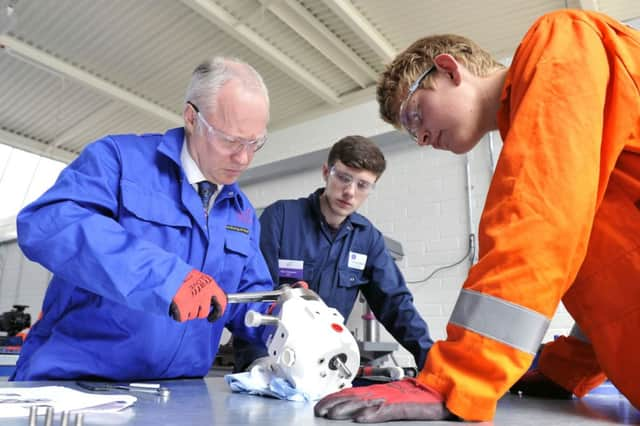Work-based learning can fill skills gap


It was telling that, during an event aimed at showing the benefits apprentices can bring to engineering firms, employers agreed that the “breakfast roll run and making the tea” are things of the past.
It was telling because it neatly illustrated the shift in practices in the workplace and perceptions in the wider world.
Advertisement
Hide AdAdvertisement
Hide AdCompanies who employ one of the 25,000 Modern Apprentice new starts each year are investing in that person; they place a value on that investment and what work-based learning can bring to their business.
The recent success of Scottish Apprenticeship Week illustrates the resurgent appetite and enthusiasm for work-based learning and apprenticeships.
From the 1960s to the 1990s, the number of apprentices in the UK dropped from more than 240,000 to around 53,000.
In a generation, the number of young people leaving school to enter employment dropped from 74 per cent in 1976 to 40 per cent in 2009.
During the same period more young people were staying on at school or going on to some kind of further study.
Estimates indicate that by 2020 nearly half of all employment in the UK will be in highly-skilled roles such as professional or technical roles. For example, the recent ICT and digital technology Skills Investment Plan for Scotland predicts demand of up to 11,000 jobs per year in that sector alone in the coming years.
Yet surveys of industry, research and the resulting news headlines are testament to the numbers of workers who will be needed to fill the skills gap.
Demand for more people with higher-level skills is expected to be strong in the sectors that should be leading to sustained economic growth, such as engineering, science, manufacturing and construction.
Advertisement
Hide AdAdvertisement
Hide AdThe so-called “retirement bulge” as baby-boomers pick up their pensions is set to place a huge demand on the workforce.
Despite record levels of investment in education, high youth unemployment persists alongside industry concerns about shortages of skills.
So how do we reconcile these anomalies? The answer must lie in a greater convergence between industry demand and skills supply. Industry co-investing with education through more dynamic work-based pathways could, in time, substantially improve youth employment and close the emerging skills gaps.
The development and expansion of Scotland’s Modern Apprenticeship programme can play a central role in building new work-based pathways.
Foundation apprenticeships will allow young people to begin their work-based learning while in senior phase of secondary school.
Key components remain a coherent programme of learning reinforced through national occupational standards; industry certification; work-based experience and application, but all at an earlier stage.
The benefits include building better links between employers and schools; providing pathways directly into employment and ensuring industry can directly shape the workforce of the future.
These benefits chime with the increasing calls for a shift in industry from being “passive consumers” of the education system towards being active co-investors.
Advertisement
Hide AdAdvertisement
Hide AdBut work-based learning at secondary school would not limit the pathways or opportunities post-school; quite the opposite.
Those choosing this route would have the option of completing a Modern Apprenticeship, going on to an HND or a university degree.
Therefore, foundation apprenticeships alongside advanced or higher level apprenticeships will provide a hybrid model of learning by offering experience in the workplace at the same time as participating in higher education.
We need to dispense with the division between “vocational” and “academic” education and build a system that develops skills that are fit for purpose and will meet the current and future needs of employers.
The blend has brought dividends in the form of economic and social benefits to many European countries.
There is a clear and direct correlation between higher levels of youth unemployment and lower levels of work-based or vocational learning in secondary education across European countries.
For example, in Austria in 2010 the level of participation in vocational upper secondary education was more than double that in the UK; the unemployment rate for under-25s was half of that in the UK.
There’s a real opportunity for Scotland to develop new, more dynamic, work-based career pathways for the future.
Advertisement
Hide AdAdvertisement
Hide AdWe already have many of the requirements of a world-class skills system in our higher education institutes, and with the Curriculum for Excellence and the Modern Apprenticeship programme.
The challenge now is how best to leverage these considerable assets to create more dynamic, work-based pathways and drive greater convergence between industry demand and skills supply.
• Damien Yeates is chief executive of Skills Development Scotland www.skillsdevelopmentscotland.co.uk
SEE ALSO